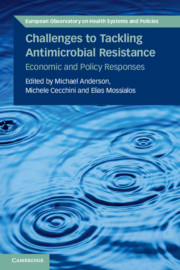74 results
Chapter 1 - History’s Prehistory
- from I - Histories
-
-
- Book:
- The New Modernist Studies
- Published online:
- 21 January 2021
- Print publication:
- 04 February 2021, pp 25-40
-
- Chapter
- Export citation
Lotteries, Art Markets, and Visual Culture in the Low Countries, 15th–17th Centuries. Sophie Raux. Studies in the History of Collecting and Art Markets 4. Leiden: Brill, 2018. xx + 370 pp. $159.
-
- Journal:
- Renaissance Quarterly / Volume 73 / Issue 4 / Winter 2020
- Published online by Cambridge University Press:
- 22 January 2021, pp. 1366-1367
- Print publication:
- Winter 2020
-
- Article
- Export citation
Figures
-
- Book:
- Challenges to Tackling Antimicrobial Resistance
- Published online:
- 21 March 2020
- Print publication:
- 23 April 2020, pp xi-xii
-
- Chapter
-
- You have access
- Open access
- HTML
- Export citation
Abbreviations
-
- Book:
- Challenges to Tackling Antimicrobial Resistance
- Published online:
- 21 March 2020
- Print publication:
- 23 April 2020, pp xv-xviii
-
- Chapter
-
- You have access
- Open access
- HTML
- Export citation
Foreword
-
- Book:
- Challenges to Tackling Antimicrobial Resistance
- Published online:
- 21 March 2020
- Print publication:
- 23 April 2020, pp ix-ix
-
- Chapter
-
- You have access
- Open access
- HTML
- Export citation
Acknowledgements
-
- Book:
- Challenges to Tackling Antimicrobial Resistance
- Published online:
- 21 March 2020
- Print publication:
- 23 April 2020, pp x-x
-
- Chapter
-
- You have access
- Open access
- HTML
- Export citation
Index
-
- Book:
- Challenges to Tackling Antimicrobial Resistance
- Published online:
- 21 March 2020
- Print publication:
- 23 April 2020, pp 241-250
-
- Chapter
-
- You have access
- Open access
- HTML
- Export citation
Additional material
-
- Book:
- Challenges to Tackling Antimicrobial Resistance
- Published online:
- 21 March 2020
- Print publication:
- 23 April 2020, pp v-v
-
- Chapter
-
- You have access
- Open access
- HTML
- Export citation
Contents
-
- Book:
- Challenges to Tackling Antimicrobial Resistance
- Published online:
- 21 March 2020
- Print publication:
- 23 April 2020, pp vii-viii
-
- Chapter
-
- You have access
- Open access
- HTML
- Export citation
Boxes
-
- Book:
- Challenges to Tackling Antimicrobial Resistance
- Published online:
- 21 March 2020
- Print publication:
- 23 April 2020, pp xiv-xiv
-
- Chapter
-
- You have access
- Open access
- HTML
- Export citation
Copyright page
-
- Book:
- Challenges to Tackling Antimicrobial Resistance
- Published online:
- 21 March 2020
- Print publication:
- 23 April 2020, pp iv-iv
-
- Chapter
-
- You have access
- Open access
- HTML
- Export citation
Tables
-
- Book:
- Challenges to Tackling Antimicrobial Resistance
- Published online:
- 21 March 2020
- Print publication:
- 23 April 2020, pp xiii-xiii
-
- Chapter
-
- You have access
- Open access
- HTML
- Export citation
Contributors
-
- Book:
- Challenges to Tackling Antimicrobial Resistance
- Published online:
- 21 March 2020
- Print publication:
- 23 April 2020, pp xix-xxii
-
- Chapter
-
- You have access
- Open access
- HTML
- Export citation
Additional material
-
- Book:
- Challenges to Tackling Antimicrobial Resistance
- Published online:
- 21 March 2020
- Print publication:
- 23 April 2020, pp vi-vi
-
- Chapter
-
- You have access
- Open access
- HTML
- Export citation

Challenges to Tackling Antimicrobial Resistance
- Economic and Policy Responses
-
- Published online:
- 21 March 2020
- Print publication:
- 23 April 2020
-
- Book
-
- You have access
- Open access
- Export citation
Charismatic leadership: Beyond love and hate and toward a sense of belonging?
-
- Journal:
- Journal of Management & Organization / Volume 25 / Issue 3 / May 2019
- Published online by Cambridge University Press:
- 21 May 2019, pp. 398-413
-
- Article
- Export citation
8 - The Baltic Sea
- from Part II - Seas
-
-
- Book:
- Oceanic Histories
- Published online:
- 01 December 2017
- Print publication:
- 07 December 2017, pp 209-233
-
- Chapter
- Export citation
“German Sailors, 1650-1900”
- from CONTRIBUTIONS
-
-
- Book:
- Those Emblems of Hell?
- Published by:
- Liverpool University Press
- Published online:
- 10 September 2019
- Print publication:
- 18 October 2017, pp 253-266
-
- Chapter
- Export citation
Mariana de Campos Françozo, De Olinda a Holanda: O Gabinete de Curiosidades de Nassau. Campinas, Brasil: University of Campinas, 2014. 288 pp. ISBN: 9788526810716. $66.00.
-
- Journal:
- Itinerario / Volume 41 / Issue 2 / August 2017
- Published online by Cambridge University Press:
- 31 July 2017, p. 430
- Print publication:
- August 2017
-
- Article
- Export citation
39 - Marcel Duchamp, Man Ray, and Djuna Barnes
- from Part IV - Modernism in Person, Modernism in Community
-
-
- Book:
- The Cambridge History of Modernism
- Published online:
- 21 January 2017
- Print publication:
- 11 January 2017, pp 734-749
-
- Chapter
- Export citation

